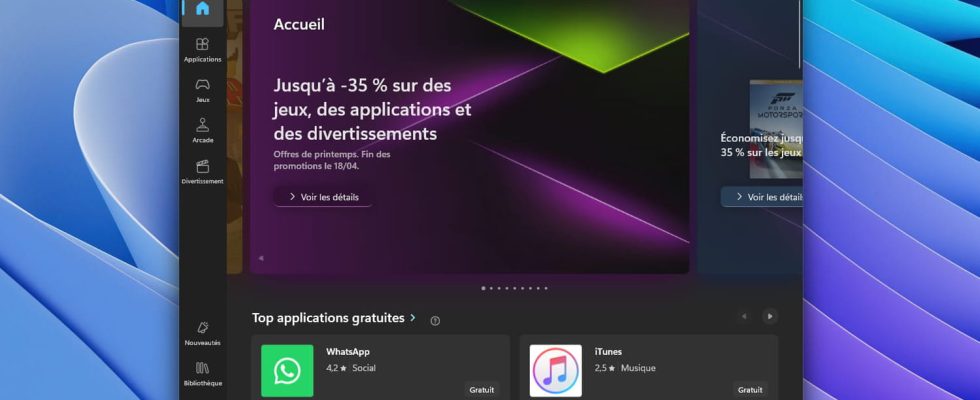Microsoft recently updated its application store, the Microsoft Store, an essential software component of the Windows operating system whose best use is paradoxically… to never open it.
If you use a Windows PC, you have undoubtedly already noticed the systematic presence of a curious icon in the taskbar, representing a white basket (or bag) with the Microsoft logo: it corresponds to the Microsoft application Store, the official Microsoft application store. A store that you have probably never visited: and for good reason!
The primary purpose of the Microsoft Store was to bring the management of applications in Windows closer to what is done on macOS, Android or Linux, by offering a single interface to discover, install, update and delete software on your computer, under the form of a “store”. Historically, installing programs on Windows consisted of downloading the desired applications from the websites of different publishers, in the form of .exe or .msi files, for example, then following a succession of settings windows, by clicking the more often hit the “Next” button without really thinking.
This installation method, which dominated the Windows universe for a long time, has become somewhat obsolete with the democratization of smartphones and their respective application stores, whether the App Store or the Play Store, which offer users the ability to install any software simply, with just one click, automatically and transparently.
The Microsoft Store was therefore supposed to bring this ease of use to Windows users, with the associated benefits in terms of security and reliability of applications: no more need to explore the Internet in search of software, at the risk of coming across sites dubious downloads which offer possibly corrupted versions of the programs; once installed, applications are automatically updated when patches or new versions are available; the initial configuration of applications, such as the choice of installation folders, is managed directly by the Microsoft Store, without requiring specific actions from the user.
Microsoft Store: an application store still useless
Unfortunately, these initial objectives do not seem to have been achieved and the Microsoft Store is still struggling to establish itself as the central solution for managing applications under Windows. First, software discovery is painful, even dangerous. The range of applications is chaotic – to say the least – and it is often difficult to find the program you are looking for. Worse, certain well-known open source applications are distributed only in… paid versions! This is the case, for example, of the very popular LibreOffice office suite, offered at a price of 4.59 euros on the Microsoft store, while this software is available easily and free of charge on the official website of its publisher.
Then, some popular and widely used applications, like the Obsidian notes manager or the Google Chrome web browser, are simply absent from the Microsoft Store. And for those that are present, such as the Mozilla Firefox browser, the presentation sheets frankly do not inspire confidence: no precise information on the version offered for download and no note on the fixes and improvements of the latest updates. So we don’t really know what we’re downloading. In addition, if one of the proposed applications is already installed elsewhere on the PC, the Microsoft Store does not detect it, and downloading it can therefore result in a double installation, thus generating confusion for the user, or even conflicts. of execution. In the centralized management genre, we have seen better.
Finally, the Microsoft Store application update manager function is also not satisfactory. Only software downloaded through the Microsoft app store is supported: any apps installed directly by the user are left out. A shame, when we know that the excellent WingetUI, a free software that we present to you here, is capable of centralizing the complete management of all the programs and applications installed on a computer, all with a much clearer and intuitive graphical interface than that of the Microsoft Store.
Ultimately, the only real use at present of the Microsoft application store is to manage updates to utilities integrated by default into Windows (which are often referred to as “native” applications), such as Photos image viewer, the Pense-Bêtes note-taking tool or the Paint graphic editor. Patches, changes and improvements to these programs go through the Microsoft Store, which downloads and installs them as soon as they are available. And the best part is that it does it automatically and in the background, without any intervention on your part! Experiment: Open the app, click the Library icon, located at the bottom of the left pane, and scroll through the list of apps in the central area. There you will see all the applications installed with Windows and the dates of their last updates.
As it stands and almost fifteen years after the publication of its very first version, the Microsoft Store is unfortunately an application store that is still unfinished, impractical and fairly useless on a daily basis. And it is not its last update, published in mid-April 2024 and supposed to significantly improve its performance, which will radically change the situation. Its effects in terms of display speed when opening the store are hardly perceptible and, above all, it does not correct the structural defects of the store: a fairly poor software offering, a difficult to read search invaded by questionable applications and a inability to effectively centralize the maintenance of programs installed on the PC. For the moment, and while waiting for a real overhaul, there is no good reason to open the Microsoft Store!



